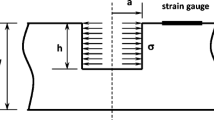Abstract
The hole drilling method is widely used in measuring residual stress in surfaces. In this method, the inclination of holes is one of the sources of error. This paper presents a finite element analysis of the influence of inclined holes on the uniaxial residual stress field. The error in stress has been found to increase proportionally to the correct inclined angle of the hole. The correction equations by which one may easily obtain the residual stress, taking account of the inclined angle and direction, have been derived. The error of stress due to the inclined hole has been reduced to around 1% using the correction equations.
Similar content being viewed by others
References
Ajovalastt, A., 1979, “Measurement of Residual Stresses by the Hole-drilling Method: Influence of Hole Eccentricity,”Journal of Strain Analysis, Vol. 14, No. 4, pp. 171–178.
ASTM Standard E837-93, 1992, Standard Test Method for Determining Residual Stresses by the Hole-Drilling Strain-Gage Method.
Flaman, M. T. and Herring, J. A., 1986, “Ultra-high-speed Center-hole Technique for Difficult Machining Materials,”Experimental Technique, Vol. 10, pp. 34–35.
Joo, J. W. and Park, C. K., 1998, “Determination of Non-uniform Residual Stresses by the Hole Drilling Method,”Transactions of the KSME, Vol. 22, No. 2, pp. 268–277 (in Korean).
Kim, C., Seok, C. S. and Yang, W. H., 2000, “Influence of the Hole Eccentricity in Residual Stresses Measurement by the Hole-drilling Method,”Transactions of the KSME, Vol. 24, No. 8, pp. 2059–2064 (in Korean).
Mathar, J., 1934, “Determination of Initial Stresses by Measuring the Deformation Around Drilled Holes,”Trans. ASME, Iron & Steel, Vol. 56, pp. 249–254.
Measurements Group, 1993, “Measurement of Residual Stresses by the Hole-Drilling Strain Gage Method,”Measurement Group Tech. Note, TN-503-5, pp. 1-15.
Schajer, G. S., 1981, “Application of Finite Element Calibrations of Residual Stress Measurement,”Journal of Engineering Materials and Technology, Vol 110, pp. 338–343.
Schajer, G. S., 1988, “Measurement of Non-Uniform Residual Stresses Using the Hole-Drilling Method. Part I — Stress Calculation Procedures,”Journal of Engineering Materials and Technology, Vol 103, pp. 157–163.
Schajer, G. S. and Alms, E., 1996, “Stress Calculation Error Analysis for Incremental Hole-Drilling Residual Stress Measurements,”Journal of Engineering Materials and Technology, Vol. 118, pp. 120–126.
Schajer, G. S. and Tootoonian. M., 1997, “A New Rosette Design for More Reliable Hole-drilling Residual Stress Measurements,”Experimental Mechanics, pp. 299–306.
Seok, C. S., Shu, M. W. and Park, J. H., 1999, “Investigation of Welding Residual Stress of High Tensile Steel by Finite Element Method and Experiment,”KSME International Journal, Vol. 13, No. 12, pp. 879–885.
Timoschenko, S. P. and Goodier, J. N., 1970, Theory of Elasticity, 3rd ed, McGraw-Hill, pp. 90–97.
Tootoonian, M. and Schajer, G. S., 1995, “Enhanced Sensitivity Residual-stress Measurements Using Taper-hole Drilling,”Experimental Mechanics, pp. 124–129.
Vangi, Dario, 1994, “Data Management for the Evaluation of Residual Stresses by the Hole-Drilling Method,”Journal of Engineering Materials and Technology, Vol 116, pp. 561–566.
Yang, Y. S., Lee, S. H. and Lee. C. S., 1998, “Analysis of Residual Stress and Strength in the Laser Spot Weldment,”Transactions of the KSME, Vol. 22, No. 6, pp. 1016–1021 (in Korean).
Yen, H. J. and Lin, M. C. C., 1995, “Measurement of Residual Stress in the Weld Overlay Piping Components,”Experimental Mechanics, pp. 89–96.
Author information
Authors and Affiliations
Corresponding author
Rights and permissions
About this article
Cite this article
Kim, C., Yang, WH. & Heo, S.P. Influence of inclined holes in measurement of residual stress by the hole drilling method. KSME International Journal 15, 1647–1654 (2001). https://doi.org/10.1007/BF03185119
Received:
Revised:
Issue Date:
DOI: https://doi.org/10.1007/BF03185119




